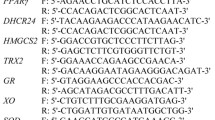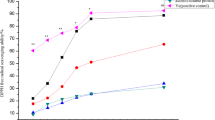Abstract
A total of 80 female albino mice were randomly allotted into five groups (n = 16) as follows: (A) normal control, (B) high-fat diet (HFD),; (C) HFD + probiotics (P), (D) HFD + sodium selenite (SS), and (E) HFD + selenium-enriched probiotics (SP). The selenium content of diets in groups A, B, C, D, and E was 0.05, 0.05, 0.05, 0.3, and 0.3 μg/g, respectively. The amount of probiotics contained in groups C and E was similar (Lactobacillus acidophilus 0.25 × 1011/mL and Saccharomyces cerevisiae 0.25 × 109/mL colony-forming units (CFU)). The high-fat diet was composed of 15 % lard, 1 % cholesterol, 0.3 % cholic acid, and 83.7 % basal diet. At the end of the 4-week experiment, blood and liver samples were collected for the measurements of lipid metabolism, antioxidative status, histopathological lesions, and related gene expressions. The result shows that HFD significantly increased the body weights and liver damages compared to control, while P, SS, or SP supplementation attenuated the body weights and liver damages in mice. P, SS, or SP supplementation also significantly reversed the changes of alanine aminotransferase (AST), aspartate aminotransferase (ALT), total cholesterol (TC), triglyceride (TG), low-density lipoprotein (LDL), total protein (TP), high-density lipoprotein (HDL), glutathione peroxidase (GSH-Px), superoxide dismutase (SOD), catalasa (CAT), and malondialdehyde (MDA) levels induced by HFD. Generally, adding P, SS, or SP up-regulated mRNA expression of carnitine palmitoyltransferase-I (CPT1), carnitine palmitoyltransferase II (CPT2), acetyl-CoA acetyltransferase II (ACAT2), acyl-coenzyme A oxidase (ACOX2), and peroxisome proliferator-activated receptor alpha (PPARα) and down-regulated mRNA expression of fatty acid synthase (FAS), lipoprotein lipase (LPL), peroxisome proliferator-activated receptor gamma (PPARγ), and sterol regulatory element-binding protein-1 (SREBP1) involved in lipid metabolism. Among the group, adding SP has a maximum effect in improving lipid metabolism, antioxidative status, histopathological lesions, and related gene expression in mice fed a HFD.






Similar content being viewed by others
References
Vargas-Robles H, Rios A, Arellano-Mendoza M, Escalante BA, Schnoor M (2015) Antioxidative diet supplementation reverses high-fat diet-induced increases of cardiovascular risk factors in mice. Oxidative Med Cell Longev 2015:467471
Fan Y, Liu Y, Xue K, Gu G, Fan W, Xu Y, Ding Z (2015) Diet-induced obesity in male C57BL/6 mice decreases fertility as a consequence of disrupted blood-testis barrier. PLoS One 10(4), e0120775
Rebuffe-Scrive M, Surwit R, Feinglos M, Kuhn C, Rodin J (1993) Regional fat distribution and metabolism in a new mouse model (C57BL6J) of non-insulin-dependent diabetes mellitus. Metab Clin Exp 42(11):1405–1409
Surwit RS, Kuhn CM, Cochrane C, McCubbin JA, Feinglos MN (1988) Diet-induced type II diabetes in C57BL/6J mice. Diabetes 37(9):1163–1167
Paccaud F, Schlüter-Fasmeyer V, Wietlisbach V, Bovet P (2000) Dyslipidemia and abdominal obesity: an assessment in three general populations. J Clin Epidemiol 53(4):393–400
Kumar S, Mahajan BB, Kamra N (2014) Future perspective of probiotics in dermatology: an old wine in new bottle. Dermatol Online J 20(9)
Park D-Y, Ahn Y-T, Park S-H, Huh C-S, Yoo S-R, Yu R, Sung M-K, McGregor RA, Choi M-S (2013) Supplementation of Lactobacillus curvatus HY7601 and Lactobacillus plantarum KY1032 in diet-induced obese mice is associated with gut microbial changes and reduction in obesity. PLoS One 8(3), e59470
Alzate A, Canas B, Perez-Munguia S, Hernandez-Mendoza H, Perez-Conde C, Gutierrez AM, Camara C (2007) Evaluation of the inorganic selenium biotransformation in selenium-enriched yogurt by HPLC-ICP-MS. J Agric Food Chem 55(24):9776–9783
Behne D, Alber D, Kyriakopoulos A (2010) Long-term selenium supplementation of humans: selenium status and relationships between selenium concentrations in skeletal muscle and indicator materials. J Trace Elem Med Biol 24(2):99–105
Gao J, Huang K, Sn Q (2006) Determination of selenomethionine in selenium-enriched yeast by gas chromatography-mass spectrometry. Se pu = Chin J Chromatogr/Zhongguo hua xue hui 24(3):235–238
Pan C, Huang K, Zhao Y, Qin S, Chen F, Hu Q (2007) Effect of selenium source and level in hen’s diet on tissue selenium deposition and egg selenium concentrations. J Agric Food Chem 55(3):1027–1032
Bancroft NH, Designed By-Cunningham F (1996) Implementing SAP r/3: prentice hall PTR
Gan F, Chen X, Liao SF, Lv C, Ren F, Ye G, Pan C, Huang D, Shi J, Shi X (2014) Selenium-enriched probiotics improve antioxidant status, immune function, and selenoprotein gene expression of piglets raised under high ambient temperature. J Agric Food Chem 62(20):4502–4508
Ibrahim HA, Zhu Y, Wu C, Lu C, Ezekwe MO, Liao SF, Huang K (2012) Selenium-enriched probiotics improves murine male fertility compromised by high fat diet. Biol Trace Elem Res 147(1-3):251–260
Kondo S, Xiao JZ, Satoh T, Odamaki T, Takahashi S, Sugahara H, Yaeshima T, Iwatsuki K, Kamei A, Abe K (2010) Antiobesity effects of Bifidobacterium breve strain B-3 supplementation in a mouse model with high-fat diet-induced obesity. Biosci Biotechnol Biochem 74(8):1656–1661
Fukushima M, Nakano M (1995) The effect of a probiotic on faecal and liver lipid classes in rats. Br J Nutr 73(5):701–710
DiStefano MT, Danai LV, Roth Flach RJ, Chawla A, Pedersen DJ, Guilherme A, Czech MP (2015) The lipid droplet protein Hypoxia-inducible gene 2 promotes hepatic triglyceride deposition by inhibiting lipolysis. J Biol Chem
Zhu PL, Pan SY, Zhou SF, Zhang Y, Wang XY, Sun N, Chu ZS, Yu ZL, Ko KM (2015) Effects of combined dietary supplementation with fenofibrate and Schisandrae Fructus pulp on lipid and glucose levels and liver function in normal and hypercholesterolemic mice. Drug Des Devel Ther 9:923–935
Adebayo AO, Zandbergen F, Kozul-Horvath CD, Gruppuso PA, Hamilton JW (2015) Chronic exposure to low-dose arsenic modulates lipogenic gene expression in mice. J Biochem Mol Toxicol 29(1):1–9
Yu L, Yang S, Sun L, Jiang YF, Zhu LY (2014) Effects of selenium-enriched Agaricus blazei Murill on liver metabolic dysfunction in mice, a comparison with selenium-deficient Agaricus blazei Murill and sodium selenite. Biol Trace Elem Res 160(1):79–84
Song M, Park S, Lee H, Min B, Jung S, Park S, Kim E, Oh S (2015) Effect of Lactobacillus acidophilus NS1 on plasma cholesterol levels in diet-induced obese mice. J Dairy Sci 98(3):1492–1501
Kunitomo M (2007) Oxidative stress and atherosclerosis. Yakugaku zasshi : J Pharm Soc Jpn 127(12):1997–2014
Rindler PM, Plafker SM, Szweda LI, Kinter M (2013) High dietary fat selectively increases catalase expression within cardiac mitochondria. J Biol Chem 288(3):1979–1990
Chen L, Pan DD, Zhou J, Jiang YZ (2005) Protective effect of selenium-enriched Lactobacillus on CCl4-induced liver injury in mice and its possible mechanisms. World J Gastroenterol 11(37):5795–5800
Kaushal D, Kansal VK (2012) Probiotic Dahi containing Lactobacillus acidophilus and Bifidobacterium bifidum alleviates age-inflicted oxidative stress and improves expression of biomarkers of ageing in mice. Mol Biol Rep 39(2):1791–1799
Zhang B, Piao J, Gu L (2002) Effects of selenium-enriched garlic on blood lipids and lipid peroxidation in experimental hyperlipidemic rats. Wei sheng yan jiu = J Hyg 31(2):93–96
Riss J, Decorde K, Sutra T, Delage M, Baccou JC, Jouy N, Brune JP, Oreal H, Cristol JP, Rouanet JM (2007) Phycobiliprotein C-phycocyanin from Spirulina platensis is powerfully responsible for reducing oxidative stress and NADPH oxidase expression induced by an atherogenic diet in hamsters. J Agric Food Chem 55(19):7962–7967
Konstandi M, Shah YM, Matsubara T, Gonzalez FJ (2013) Role of PPARalpha and HNF4alpha in stress-mediated alterations in lipid homeostasis. PLoS One 8(8), e70675
Patsouris D, Reddy JK, Muller M, Kersten S (2006) Peroxisome proliferator-activated receptor alpha mediates the effects of high-fat diet on hepatic gene expression. Endocrinology 147(3):1508–1516
Peng Y, Rideout D, Rakita S, Lee J, Murr M (2012) Diet-induced obesity associated with steatosis, oxidative stress, and inflammation in liver. Surg Obes Relat Dis 8(1):73–81
Schultz A, Neil D, Aguila MB, Mandarim-de-Lacerda CA (2013) Hepatic adverse effects of fructose consumption independent of overweight/obesity. Int J Mol Sci 14(11):21873–21886
Wu T, Guo A, Shu Q, Qi Y, Kong Y, Sun Z, Sun S, Fu Z (2015) L-Carnitine intake prevents irregular feeding-induced obesity and lipid metabolism disorder. Gene 554(2):148–154
Hu X, Wang T, Li W, Jin F, Wang L (2013) Effects of NS Lactobacillus strains on lipid metabolism of rats fed a high-cholesterol diet. Lipids Health Dis 12:67
Zhang H, Zhang X, Wang Z, Dong X, Tan C, Zou H, Peng Q, Xue B, Wang L, Dong G (2015) Effects of dietary energy level on lipid metabolism-related gene expression in subcutaneous adipose tissue of Yellow breed x Simmental cattle. Anim Sci J = Nihon chikusan Gakkaiho 86(4):392–400
Goto T, Kim YI, Funakoshi K, Teraminami A, Uemura T, Hirai S, Lee JY, Makishima M, Nakata R, Inoue H (2011) Farnesol, an isoprenoid, improves metabolic abnormalities in mice via both PPARalpha-dependent and -independent pathways. Am J Physiol Endocrinol Metab 301(5):E1022–E1032
Xin J, Zeng D, Wang H, Ni X, Yi D, Pan K, Jing B (2014) Preventing non-alcoholic fatty liver disease through Lactobacillus johnsonii BS15 by attenuating inflammation and mitochondrial injury and improving gut environment in obese mice. Appl Microbiol Biotechnol 98(15):6817–6829
Fak F, Backhed F (2012) Lactobacillus reuteri prevents diet-induced obesity, but not atherosclerosis, in a strain dependent fashion in Apoe-/- mice. PLoS One 7(10), e46837
Kimura R, Takahashi N, Murota K, Yamada Y, Niiya S, Kanzaki N, Murakami Y, Moriyama T, Goto T, Kawada T (2011) Activation of peroxisome proliferator-activated receptor-alpha (PPARalpha) suppresses postprandial lipidemia through fatty acid oxidation in enterocytes. Biochem Biophys Res Commun 410(1):1–6
Landa V, Zidek V, Mlejnek P, Simakova M, Silhavy J, Trnovska J, Kazdova L, Pravenec M (2014) Sterol regulatory element binding protein 2 overexpression is associated with reduced adipogenesis and ectopic fat accumulation in transgenic spontaneously hypertensive rats. Physiol Res 63(5):587–590
Acknowledgments
This work was funded by the National Natural Science Foundation of China (31272627, 31472253) and the Priority Academic Program Development of Jiangsu Higher Education Institutions (Jiangsu, China).
Author information
Authors and Affiliations
Corresponding author
Ethics declarations
Conflict of Interest
The authors declare that they have no competing interests.
Rights and permissions
About this article
Cite this article
Nido, S.A., Shituleni, S.A., Mengistu, B.M. et al. Effects of Selenium-Enriched Probiotics on Lipid Metabolism, Antioxidative Status, Histopathological Lesions, and Related Gene Expression in Mice Fed a High-Fat Diet. Biol Trace Elem Res 171, 399–409 (2016). https://doi.org/10.1007/s12011-015-0552-8
Received:
Accepted:
Published:
Issue Date:
DOI: https://doi.org/10.1007/s12011-015-0552-8




